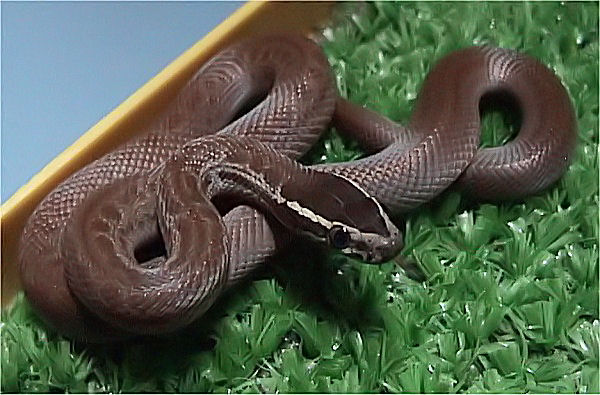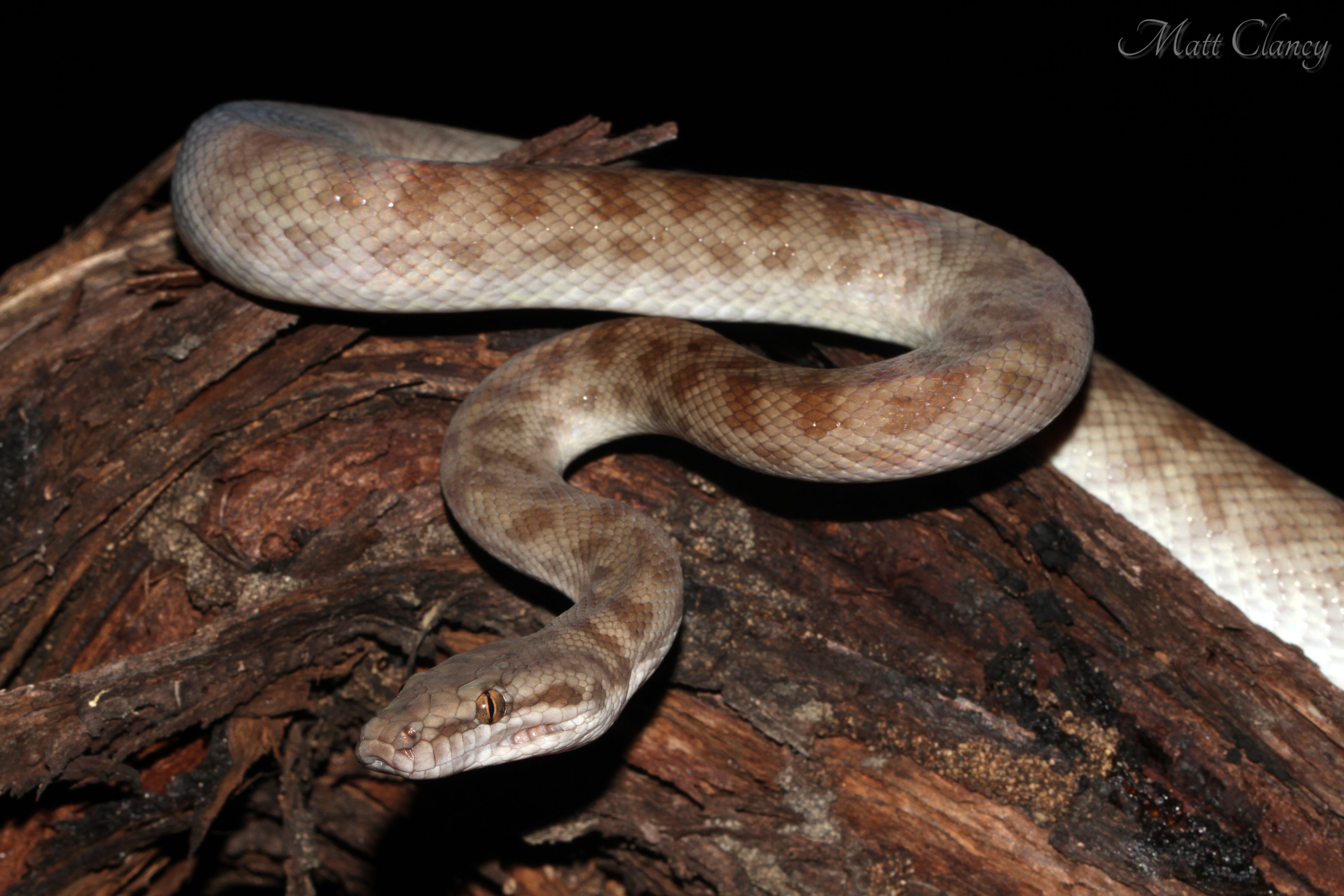The African house snake (Boaedon fuliginosus) is also known as the brown house snake. They are small- to medium-sized, terrestrial, nocturnal snakes found throughout western and sub-Saharan Africa. They have adapted to a wide variety of habitats, including scrubland, woodland, savannah, and grassland, but seem to avoid desert and forests.
African house snakes are typically 2-4’ long, with females being significantly larger than males. They have a slender body, oval head, smooth scales, and large, round eyes with vertical pupils. Coloring is typically light brown to black with a pale stripe extending from the snout to the ear. Appearance can be highly variable, however — some have spots or blotches, some have stripes that run the length of their body, and some are alternative colors like orange or dark green.
Because of their general hardiness, small size, and docility, African house snakes are considered beginner-level pet reptiles. However, they still have specific care needs that must be met. With good care, they live an average of 9 years, but are likely capable of living longer.
How much space do African house snakes need?
Because African house snakes are slender, many people think of them as smaller than they really are, keeping them in enclosures that are too small for them to stretch out fully and exercise. The minimum for appropriately keeping one African house snake is 36”L x 18”W x 16”H. This is just the minimum, so using larger dimensions is beneficial and will happily be used!
Cohabitation (keeping multiple African house snakes in one enclosure) is not recommended, as these are snakes are known to have cannibalistic tendencies.
Do African house snakes need UVB?
They can survive without it, but it’s still best practice to provide UVB lighting for optimal health and wellbeing. UVB gives snakes all of the vitamin D that their bodies need, stimulates better appetite and activity, and generally allows them to be healthier than they would be without.
The best UVB bulbs for African house snakes are:
- Zoo Med T5 HO Reptisun 5.0
- Arcadia Forest 6%
The UVB bulb should be half the length of the enclosure, housed in a reflective fixture, and placed close to the heat lamp on top of the enclosure, no closer than 6” above the basking area. UVB is blocked by glass and plastic, so you can’t give your snake UVB by placing its terrarium in front of an open window. Also make sure that the fixture your UVB bulb is in does not have a clear plastic bulb cover.
Lights should be on for 13 hours/day during summer and 11 hours/day during winter. This helps encourage more natural hormonal rhythms and better long-term health.
What basking temperatures do African house snakes need?
Like other reptiles, African house snakes are ectotherms, which means that they need a temperature gradient in their enclosure to help them regulate their metabolism and stay healthy.
African snakes should have a basking temperature of 90°F. On the other side of the enclosure, the temperature should be between 70-75°F. Track the temperatures in your enclosure with two digital probe thermometers.
Provide heat for your snake by imitating the sun with a halogen heat lamp placed on one side of the enclosure, positioned over a sturdy basking branch or warm hide. Do not use ceramic heat emitters (CHEs), red bulbs, or blue bulbs, as these are not as effective.
If the heat lamp is not enough to get the warm hide to an appropriate temperature, use a heat mat connected to a thermostat to control the warm hide temperature.
What humidity levels do African house snakes need?
African house snakes need an average humidity of 40-60%, as measured by a digital probe hygrometer placed in the middle of the enclosure. There should also be a humid hide for your snake, lined with moistened sphagnum moss. Always having a humid retreat available is essential to having a well-hydrated snake.
Misting your snake’s enclosure with a sprayer each evening will help create the right humidity levels. If you need more, moisten the substrate by mixing water into it as needed.
What substrate is good for African house snakes?
African house snakes require a thick layer of moisture-retentive substrate to cushion their bodies and help maintain healthy humidity levels. As an added perk, it also tends to make the enclosure more attractive.
Ideally, this substrate should resemble what the snakes naturally live on in the wild: soil. It should have small particles and hold moisture well. We recommend the following substrates for African house snakes:
Layering clean, chemical-free leaf litter on top of the substrate can also help with humidity.
Substrate should be at least 2” deep and completely replaced every 3-4 months. Remove poop and urates daily, along with contaminated substrate.
What décor can you use in a African house snake terrarium?
It’s terribly boring for a snake to be stuck in an enclosure with nothing in it except substrate, hides, and a water bowl. It doesn’t matter how big the enclosure is if you don’t put things in it for your pet to use and interact with.
Aside from hiding places, you will also need at least one low branch for your snake to climb on, as well as some live or artificial foliage to provide cover. Additional options include:
What do African house snakes eat?
Like other snakes, African house snakes are carnivores, which means that they need to eat whole animal prey in order to get the nutrition that they need. Here is a basic feeding schedule based on snake age:
- Juveniles should be fed once per week.
- Adults should be fed once every two weeks.
Prey items should be around 10% of your snake’s weight or no more than 1.5x its width. Although live prey can be used, it’s safest and most humane to use frozen instead. Prey should be thawed in a plastic bag in warm water to approximately 100°F before offering with a pair of soft-tipped tweezers.
Remember, the key to great nutrition is variety! Aside from offering mice and rats, young hamsters, gerbils, button quail, and even feeder lizards can also be used to create nutritional variety in your snake’s diet.
Supplements
African house snakes can survive without vitamin or mineral supplements, but occasionally using them can help prevent nutritional deficiencies and optimize your snake’s health. We recommend Repashy Calcium Plus LoD.
Water
Your snake should have access to clean, fresh water at all times. Provide a water bowl large enough for the snake to soak its entire body if desired. Change the water daily and scrub the bowl with a reptile-safe disinfectant weekly, or whenever it becomes soiled.
Do African house snakes like to be handled?
Few reptiles actually “like” to be held, but African house snakes generally tolerate handling well. That being said, they can be nippy and squirmy as babies, so be cautious. Be gentle, and pick up the snake from below rather than from above. Avoid forcefully restraining them. Support as much of its body as possible, and NEVER pick up a snake by its tail!
*This care sheet contains only very basic information. Although it’s a good introduction, please do further research with high-quality sources to obtain additional information on caring for this species.
"File:Boaedon fuliginosus.jpg" by The original uploader was Dawson at English Wikipedia. is licensed under CC BY-SA 2.5




Leave a comment
This site is protected by hCaptcha and the hCaptcha Privacy Policy and Terms of Service apply.